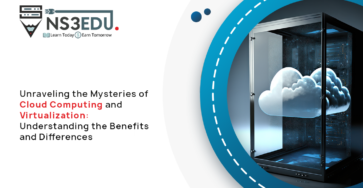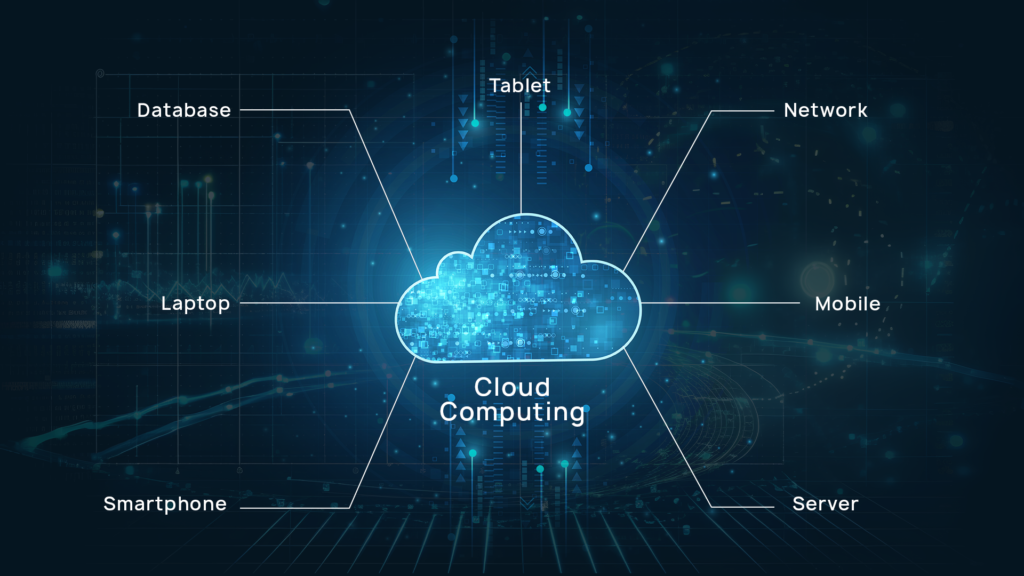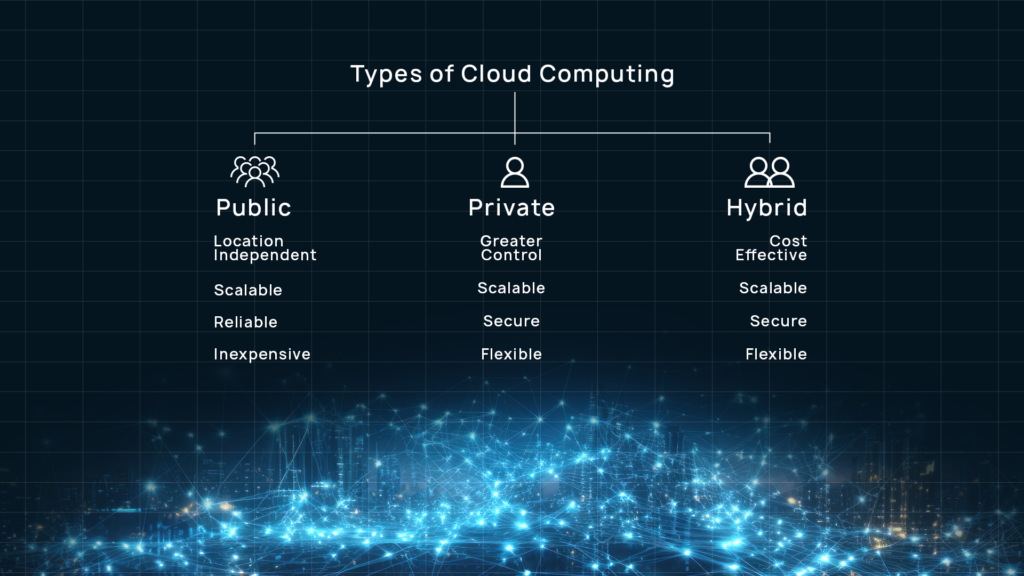
Computing and virtualization have become buzzwords in the IT world, but what do they really mean? In this article, we will explore the basics of cloud computing and virtualization, their benefits, and the differences between them. We will also look at the various types of cloud services, security considerations, and trends to watch. By the end of this article, you will have a better understanding of these technologies and how they can benefit your business.
Introduction to Cloud Computing and Virtualization
What is Cloud Computing and How Does it Work?

Cloud computing is the delivery of computing services over the internet. Instead of having to install and maintain software on your own computer or servers, you can access it through the internet. Cloud computing allows you to store and access data, run applications, and even run your entire IT infrastructure without having to invest in expensive hardware and software.
In cloud computing, the computing resources such as servers, storage, and databases are hosted in data centers operated by cloud service providers. These providers offer different types of cloud services that cater to different needs.
Benefits of Cloud Computing and Virtualization
Cloud computing and virtualization offer numerous benefits to businesses, including:
-
Cost Savings: With cloud computing, you only pay for what you use, which means you can avoid the upfront costs of purchasing and maintaining hardware and software. Virtualization allows you to run multiple virtual machines on a single physical machine, which can also save on hardware costs.
-
Scalability: Cloud computing and virtualization allow you to scale up or down your IT resources as needed. This means you can quickly respond to changes in demand without having to invest in new hardware.
-
Flexibility: Cloud computing allows you to access your data and applications from anywhere with an internet connection. Virtualization allows you to run multiple operating systems and applications on a single physical machine, which gives you more flexibility in how you use your IT resources.
-
Reliability: Cloud service providers offer high levels of uptime and reliability, which means your data and applications are always available when you need them. Virtualization also offers improved reliability by reducing the risk of hardware failures.
Types of Cloud Services

Understanding the Differences Between Public, Private and Hybrid Clouds
There are three main types of cloud services: public, private and hybrid.
Public Clouds are owned and operated by third-party service providers, and the computing resources are shared among multiple customers. Public clouds are typically used for non-sensitive data and applications.
Private Clouds are owned and operated by a single organization, and the computing resources are not shared with other customers. Private clouds are typically used for sensitive data and applications that require a high level of security.
Hybrid Clouds are a combination of public and private clouds, and they allow organizations to use both types of cloud services. Hybrid clouds are typically used for organizations that have varying levels of security and compliance requirements.
Cloud Computing vs. Traditional Computing
Cloud computing differs from traditional computing in several ways. In traditional computing, software and hardware are installed and maintained on-premises by the organization. In cloud computing, the software and hardware are hosted by a third-party provider and accessed over the internet.
Cloud computing also offers several advantages over traditional computing, including:
-
Lower Costs: Cloud computing can be less expensive than traditional computing because you only pay for what you use.
-
Scalability: Cloud computing allows you to quickly scale your IT resources up or down as needed, which can be difficult with traditional computing.
-
Flexibility: Cloud computing allows you to access your data and applications from anywhere with an internet connection, which can be more convenient than traditional computing.
-
Reliability: Cloud service providers offer high levels of uptime and reliability, which can be difficult to achieve with traditional computing.
Virtualization: What it is and How it Relates to Cloud Computing
What is Virtualization?

Virtualization is the process of creating multiple virtual environments on a single physical machine. Each virtual environment, also known as a virtual machine, runs its own operating system and applications and has access to its own resources such as CPU, memory, and storage.
Advantages of Virtualization
Virtualization offers several advantages, including:
-
Cost Savings: Virtualization allows you to run multiple virtual machines on a single physical machine, which can save on hardware costs.
-
Scalability: Virtualization allows you to quickly create and deploy new virtual machines, which can be useful for testing and development purposes.
-
Flexibility: Virtualization allows you to run multiple operating systems and applications on a single physical machine, which gives you more flexibility in how you use your IT resources.
-
Reliability: Virtualization can improve reliability by reducing the risk of hardware failures and allowing for quick disaster recovery.
Cloud Computing and Virtualization Security Considerations
While cloud computing and virtualization offer numerous benefits, they also present security considerations that must be addressed. These considerations include:
-
Data Security: Cloud service providers must ensure the security and privacy of their customers’ data. This includes protecting data from unauthorized access, ensuring data is not lost or corrupted, and providing secure access to data.
-
Network Security: Cloud service providers must ensure the security of their networks. This includes protecting against network attacks, ensuring network availability, and providing secure access to the network.
-
Virtual Machine Security: Virtual machines must be secured to prevent unauthorized access and to protect against malware and other threats. This includes ensuring that virtual machines are updated with the latest security patches, and that access to virtual machines is restricted to authorized personnel.
Choosing the Right Cloud Computing and Virtualization Solution for Your Business
Choosing the right cloud computing and virtualization solution for your business can be a daunting task. Here are some factors to consider:
-
Cost: Consider the upfront and ongoing costs of the solution, including hardware, software, and maintenance.
-
Scalability: Consider whether the solution can scale up or down as your needs change.
-
Flexibility: Consider whether the solution can meet your specific needs, including the ability to run different operating systems and applications.
-
Security: Consider the security features of the solution, including data security, network security, and virtual machine security.
-
Service Level Agreements (SLAs): Consider the SLAs offered by the cloud service provider. These SLAs should specify the level of uptime, availability, and support you can expect.
Cloud Computing and Virtualization Trends to Watch
Cloud computing and virtualization are constantly evolving, and there are several trends to watch in the coming years. These trends include:
-
Edge Computing: Edge computing involves processing data closer to the source rather than in a centralized data center. This can reduce latency and improve performance.
-
Serverless Computing: Serverless computing allows you to run code without having to manage servers or infrastructure. This can reduce costs and improve scalability.
-
Artificial Intelligence (AI): AI can be used to analyze large amounts of data and make predictions and decisions based on that data. Cloud computing and virtualization can help organizations to leverage AI by providing the necessary computing resources.
-
Blockchain: Blockchain technology can be used to create secure and transparent transactions and data sharing. Cloud computing and virtualization can help organizations to leverage blockchain by providing the necessary computing resources.
Conclusion: The Future of Cloud Computing and Virtualization
Cloud computing and virtualization have become essential technologies for businesses of all sizes. They offer numerous benefits, including cost savings, scalability, flexibility, and reliability. As these technologies continue to evolve, we can expect to see even more benefits and opportunities for businesses to leverage cloud computing and virtualization.
If you’re interested in learning more about cloud computing and virtualization, consider joining NS3Edu for IT networking training. Our courses can help you gain the skills and knowledge you need to succeed in this exciting and rapidly evolving field.
Ready to unleash your true potential? Don’t wait any longer! Enroll in our Courses today and take your networking skills to new heights.
For more information, visit our website at 🌐 www.ns3edu.com
Contact us now at 📞+91 88 000 111 38 or 📨 [email protected] and explore the wide range of programs we offer. It’s time to embark on an educational journey that will transform your career. Don’t miss out on this opportunity – reach out to us today!
